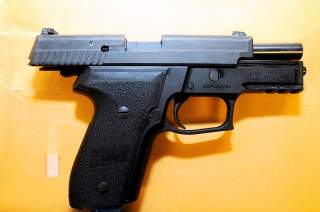Sig vs. Sig: Sig Sauer's P226 Gun vs. P229 (Who Wins?)
We have a few ideas.
Because we’re all differently built on a physiological level, we’ll all have varying levels of strength. The only body parts that get punished a lot when shooting heavy-recoiling handguns are the strong hand (not so much the supporting hand) — specifically that web between the thumb and the index finger, and the wrist. Thus, we will all react differently to a gun’s recoil energy.
The long and short of it: a higher recoil energy means a more painful shooting experience, while a higher recoil velocity means higher muzzle rise, slower re-acquisition of sights and slower follow-up shots.

Light blue bar: SIG P226 recoil energy in ft.lbf; dark blue bar: SIG P229 recoil energy in ft.lbf. Lower is better.
From the shape of the graph, we can already see that the 9mm has significantly less recoil energy compared to the other two handgun calibers when fired from either a SIG P226 or P229. We can also see that the .357 SIG and the .40 S&W have about the same recoil energy.
Let’s try and crunch the numbers to get to the specifics.
Comparing a SIG P226 and a SIG P229, both chambered for the same caliber, we’ll get the following results: for the 9mm, a ~13.9 difference; for the .357 SIG, a ~14% difference, and for the .40 S&W, again a ~13.9% difference. Again, this means there is negligible recoil difference between the two handguns when both are chambered for the same handgun caliber.
Comparing two SIG P229s, one chambered for .40 S&W and the other chambered for 9mm, we get a difference of 31.39% in recoil energy. That is quite a bit of felt recoil. But it simply means the .40 S&W is a potent round and will have more felt recoil compared to a 9mm when fired from a mid-size pistol.
Comparing SIG P229 chambered for .40 S&W and SIG P226 chambered for 9mm, the difference in recoil energy is 40.93%. This means if you’re comfortable with a full-size 9mm and you’ve never fired a mid-size .40 S&W handgun before, you might hurt your hands if you decide to switch to the smaller handgun.
SO WHAT’S THE VERDICT?
Here are some things to consider before purchasing either of the two pistols:
The difference in recoil velocities and recoil energies between the two handguns is negligible assuming both are chambered for the same caliber. So if you’re wondering whether you should get a P226 or a P229 as a CCW for self defense (in whichever of the three handgun calibers available that you prefer), chances are the P229 will be the better option for you.
If you’re comfortable with the .40 S&W’s or the .357 SIG’s recoil, it won’t matter which pistol you choose. Both the SIG P226 and P229 will handle recoil well.
If you’ve only ever shot full-size 9mm handguns and you’re looking to buy your first handgun in .40 S&W, you might find the SIG P229’s recoil unpleasant, maybe even painful if you’re recoil-shy. Go to your nearby range, rent it and try shooting it first. If you don’t like the way it recoils, it’ll make more sense to purchase the SIG P226.
The slightly longer barrel, slide and sight radius of the P226 making the gun a bit more accurate still holds true, but only to a small extent. Considering how all the three calibers it can chamber are primarily used in self defense situations where people instinctively point and shoot, I highly doubt that extra 0.5 inch would offer any significant advantage — if anything it only makes the P226 a bit harder to conceal.
CONCLUSION
As far as I’m concerned, SIG Sauer is cannibalizing their P226 with their P229.
Due to the fact that the relatively smaller SIG P229 has the same ammo capacity as the SIG P226, and there is very negligible difference between the two handguns as far as handling and recoil control, I don’t see the point in buying a SIG P226.
The P229 also having a smaller grip area will be a bit easier to conceal. But if for some reason, you have ginormous hands and you think you won’t get a solid purchase on the smaller grip, the P226 will be the better option.
Also, if you play IPSC or IDPA and you need all the advantage you can get from a slightly heavier handgun with a longer slide, barrel and sight radius, (assuming you’re a cheapskate that an STI double-stack 2011 in .38 Super would be way too expensive for you, and these are the only two handguns you can choose from) then by all means get the P226.
For me personally, I just don’t see the point in getting the full-size P226 when the mid-size P229 does everything it can do, is relatively easier to conceal, has the same mag capacity and costs the exact same $$$.
I think anyone who can make sense of all the graphs I put above and all the Mathcraft I did would agree that all things considered, the P229 wins over the P226.
This article by Mike Ramientas originally appeared at Gun News Daily in 2019.
Image: Reuters.

